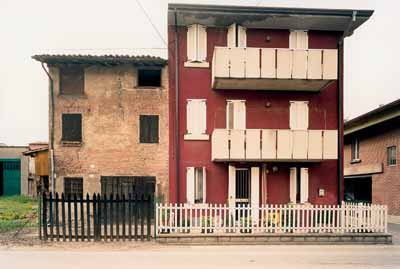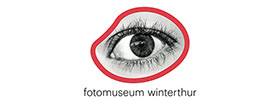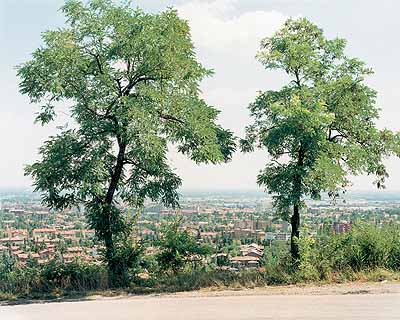
Trans Emilia - Sammlung Linea di Confine: Territoriales Erkunden der Emilia-Romagna
Marina Ballo Charmet » Lewis Baltz » Olivo Barbieri » Andrea Botto » Michele Buda » John Davies » Paola de Pietri » Gilbert Fastenaekens » John Gossage » William Guerrieri » Guido Guidi » Axel Hütte » Gianluca Liverani » Walter Niedermayr » Stephen Shore » Marco Signorini »
Exhibition: 22 Oct 2005 – 12 Feb 2006

Fotomuseum Winterthur
Grüzenstr. 44+45
8400 Winterthur
+41 (0)52-2341060
info@fotomuseum.ch
www.fotomuseum.ch
Tue, Thu, Fri 11-17; Wed 11-20; Sat-Sun 11-18
The Linea di Confine Collection: A Territorial Reconnaissance of the Emilia-Romagna The Emilia-Romagna region is strung with melodically named cities. Punctuating the over two-thousand-year-old ancient Roman road Via Emilia and the dead-straight multi-lane A1 motorway from Milan to Bologna of today are cities such as Piacenza, high up in the northwest, Parma, Modena and Bologna in the flat lowlands near the Po, and Rimini and Ravenna further southeast on the sharp coast of the Adriatic. Together they characterise the region, so astounding in its diversity of landscape, culture and economy, that extends between Lombardy and Veneto in the north and the Toscana in the south. Unfortunately, travellers only see this region of Italy as they rapidly pass through. With the soon-to-be-finished high-speed line of the Italian Railway from Milan to Bologna, a further opportunity is being promoted for the swift transit through this region, with various consequences: as a result of the transport-based link to the large Italian economic centres, regions like Reggio Emilia are being opened up to completely new, future-orientated perspectives, while other locations are slowly losing their strategic importance. The project Linea di Confine (borderline) is a combination of the extensive commissioned photographic projects that have been launched since 1989 on the initiative of the Culture Department of Rubiera, located near the city of Modena. Internationally recognised photographers such as Lewis Baltz, Stephen Shore, John Davies, John Gossage and Axel Hütte have been invited to the Emilia-Romagna with the assignment of undertaking topographical research and leading workshops with young Italian photographers on thematically formulated artistic projects on subjects of regional interest. For over fifteen years, the goal has been to use the medium of photography to investigate particular territories in order to reflect on and discuss complex perspectives on contemporary landscapes. These investigations address various levels of meaning relating to the project in question, including landscape-geographical and historical, economic, political, cultural and sociological interventions in the quickly shifting landscapes. From the wide variety of these photographic explorations, the Fotomuseum Winterthur has created an exhibition entitled "Trans Emilia – The Linea di Confine Collection: A Territorial Reconnaissance of the Emilia-Romagna". With this exhibition, the Fotomuseum Winterthur is continuing the discussion "on collecting photography". Book on the exhibition: ed. Thomas Seelig/Urs Stahel, hardcover, 20 x 24 cm, 160 pages, 110 illustrations B/W and colour, 3 Essays, German/English, published by Christoph Merian Verlag, Basel. Exhibition price: Fr. 42.- __________ deutsch ___________ Sammlung Linea di Confine: Territoriales Erkunden der Emilia-Romagna Klingende Städtenamen verbinden sich mit der Region Emilia-Romagna. Entlang der über zweitausend Jahre alten Römerstrasse Via Emilia und heute der schnurgeraden, mehrspurigen Autobahn A1 von Mailand nach Bologna reihen sich Städte auf wie Piacenza im Nordwesten und die in der flachen Tiefebene des nahen Po gelegenen Parma, Modena und Bologna, sowie weiter südöstlich an der Adriaküste Rimini und Ravenna. Sie alle sind Marksteine einer landschaftlich, kulturell und wirtschaftlich erstaunlich vielfältigen Region, die sich zwischen der Lombardei und Venetien im Norden und der Toskana im Süden erstreckt. Leider wird sie von Italienreisenden oft nur im rasenden Transit wahrgenommen. Die bald fertig gestellte Hochgeschwindigkeitstrecke der italienischen Bahn von Mailand nach Bologna wird ein weiteres Mal die rasche Durchquerung dieser Region vorantreiben, mit unterschiedlichen Auswirkungen: Ortschaften wie Reggio Emilia eröffnen sich durch die verkehrstechnische Anbindung an die grossen italienischen Wirtschaftszentren neue, zukunftsweisende Perspektiven, andere Orte dürften wohl langsam an strategischer Bedeutung verlieren. Das Projekt Linea di Confine (Grenzlinie) fasst verschiedenste Auftrags-Fotoprojekte zusammen, die seit 1989 auf Initiative des Kulturdezernats der Gemeinde Rubiera, nahe der Stadt Modena gelegen, lanciert wurden. International bekannte Fotografen wie Lewis Baltz, Stephen Shore, John Davies, John Gossage oder Axel Hütte wurden mit dem Auftrag in die Emilia-Romagna eingeladen, topografische Recherchen zu unternehmen und in Workshops mit jungen italienischen Fotografen und Fotografinnen thematisch formulierte künstlerische Projekte zu regionalen Themen zu veranstalten. Seit nun fünfzehn Jahren ist es Ziel von Linea di Confine, mit dem Medium der Fotografie ein bestimmtes Territorium zu befragen. Diese Befragungen setzten je nach Projekt auf verschiedenen Bedeutungsebenen an: entweder sind es landschaftlich-geografische oder historische, ökonomische, politische, kulturelle und soziologische Zugriffe auf die sich schnell wandelnden Landschaften. Das Fotomuseum Winterthur kuratiert aus der Vielfalt dieser fotografischen Recherchen eine Ausstellung unter dem Titel "Trans Emilia – Sammlung Linea di Confine: Territoriales Erkunden der Emilia-Romagna". Mit dieser Ausstellung führt das Fotomuseum Winterthur die Diskussion "über das Sammeln von Fotografie" fort. Buch zur Ausstellung: Hg. Thomas Seelig/Urs Stahel, Hardcover, 20 x 24 cm, 160 Seiten, 110 Abbildungen S/W und Farbe, 3 Essays, Deutsch/Englisch, erscheint im Christoph Merian Verlag, Basel. Ausstellungspreis: Fr. 42.-

